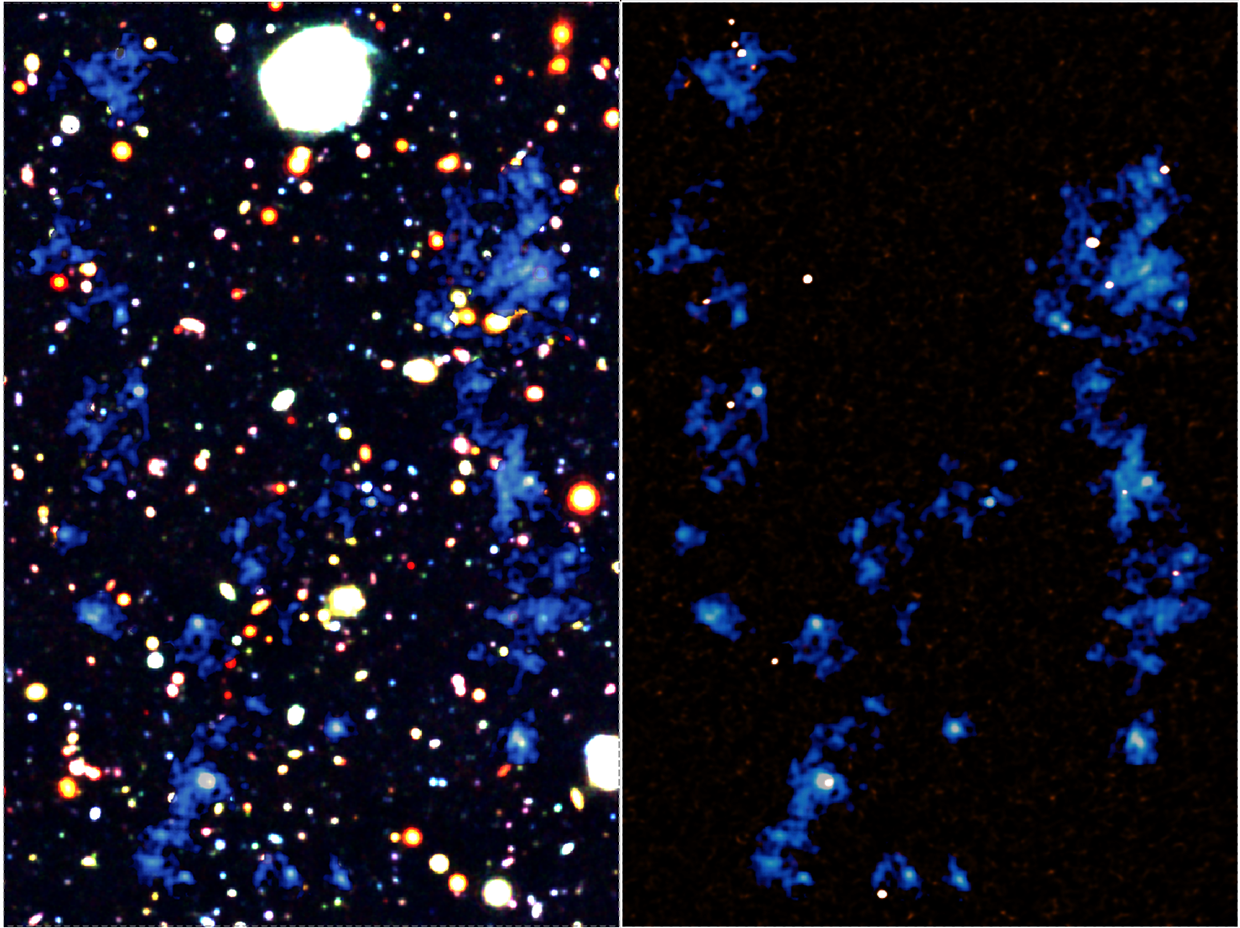Maunakea, Hawaii – An international group of scientists led by Hideki Umehata of the RIKEN Cluster for Pioneering Research, a branch of Japan’s largest scientific research organization, has made detailed observations of the filaments of gas connecting galaxies in a large protocluster in the early universe.
Based on direct observations they found that, in accordance with predictions, the filaments are extensive, extending over more than 3 million light years and are providing the fuel for intense formation of stars and the growth of super massive black holes within the protocluster.
The team’s results are published online in today’s issue of the journal Science.
The data were gathered using a global network of telescopes, including two Maunakea Observatories – the Subaru Telescope and W. M. Keck Observatory in Hawaii – along with the ESO’s Very Large Telescope (VLT) and Atacama Large Millimeter/submillimeter Array (ALMA) in Chile.
The observations, which constitute a very detailed map of the filaments, were made on SSA22, a massive protocluster of galaxies located about 12 billion light years away in the constellation of Aquarius.
The findings give key insight on the galaxy formation model. Now it is generally believed that filaments in the early universe fueled the formation of galaxies and super massive black holes at places where the filaments crossed, creating dense regions of matter.

The group showed that the intersection between the enormous filaments they identified is home to active galactic nuclei containing supermassive black holes and “starbursting” galaxies, which have very active star formation. This was done using observations from ALMA and from Keck Observatory’s Multi-Object Spectrograph for Infrared Exploration (MOSFIRE).
Their observations are also based on the detection of ultraviolet light produced by ionized hydrogen gas. This detection was done using the VLT’s Multi Unit Spectroscopic Explorer (MUSE) instrument. The radiation was found to be intense and calculations indicated that the high radiation likely originated in star-forming galaxies and growing black holes.
According to Umehata, the lead author of the paper, “This suggests very strongly that gas falling along the filaments under the force of gravity triggers the formation of starbursting galaxies and supermassive black holes, giving the universe the structure that we see today.”
“Previous observations,” he continues, “had shown that there are emissions from blobs of gas extending beyond the galaxies, but now we have been able to clearly show that these filaments are extremely long, going even beyond the edge of the field that we viewed. This adds credence to the idea that these filaments are actually powering the intense activity that we see within the galaxies inside the filaments.”
Co-author Michele Fumagalli from Durham University, UK, says, “It is very exciting to clearly see for the first time multiple and extended filaments in the early universe. We finally have a way to map these structures directly, and to understand in detail their role in regulating the formation of supermassive black holes and galaxies.”
The work was done by the RIKEN Cluster for Pioneering Research along with collaborators from the University of Tokyo, Durham University in the UK, National Astronomical Observatory of Japan, Nagoya University, and other institutes. This research is supported by KAKENHI (Numbers JP17K14252, JP25287043, JP17H04831, JP17KK0098, JP19K03925, JP17H06130, JP17H06130) and NAOJ ALMA Scientific Research Grant Number 2018-09B.
ABOUT MOSFIRE
The Multi-Object Spectrograph for Infrared Exploration (MOSFIRE) is a highly-efficient instrument that can take images or up to 46 simultaneous spectra. Using a sensitive state-of-the-art detector and electronics system, MOSFIRE obtains observations fainter than any other near infrared spectrograph. MOSFIRE is an excellent tool for studying complex star or galaxy fields, including distant galaxies in the early Universe, as well as star clusters in our own Galaxy. MOSFIRE obtained first light in April 2012 and was made possible by funding provided by the National Science Foundation.
ABOUT W. M. KECK OBSERVATORY
The W. M. Keck Observatory telescopes are among the most scientifically productive on Earth. The two, 10-meter optical/infrared telescopes on the summit of Maunakea on the Island of Hawaii feature a suite of advanced instruments including imagers, multi-object spectrographs, high-resolution spectrographs, integral-field spectrometers, and world-leading laser guide star adaptive optics systems.
Some of the data presented herein were obtained at Keck Observatory, which is a private 501(c) 3 non-profit organization operated as a scientific partnership among the California Institute of Technology, the University of California, and the National Aeronautics and Space Administration. The Observatory was made possible by the generous financial support of the W. M. Keck Foundation.
The authors wish to recognize and acknowledge the very significant cultural role and reverence that the summit of Maunakea has always had within the Native Hawaiian community. We are most fortunate to have the opportunity to conduct observations from this mountain.


